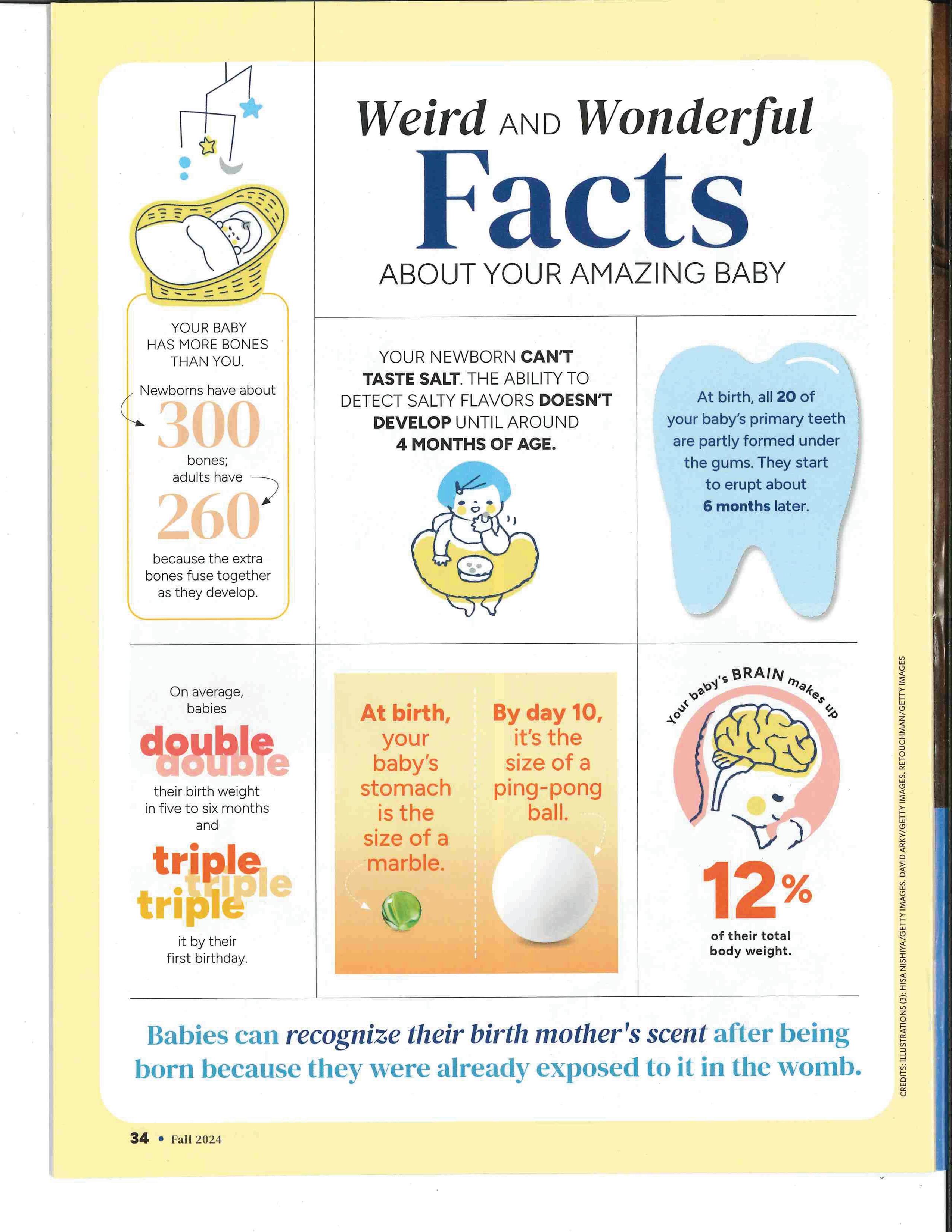






















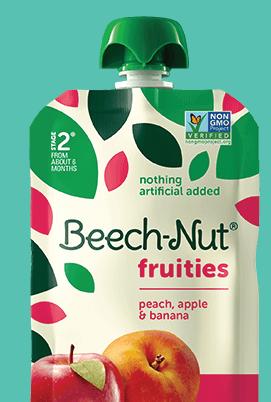




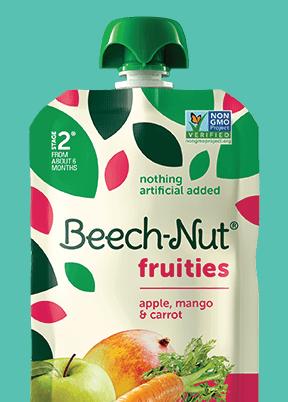







Give them the nutrition they need, wherever you are.
Beech-Nut Baby and Toddler Food Pouches are made with real ingredients and packed in convenient pouches for on-the-go feeding.
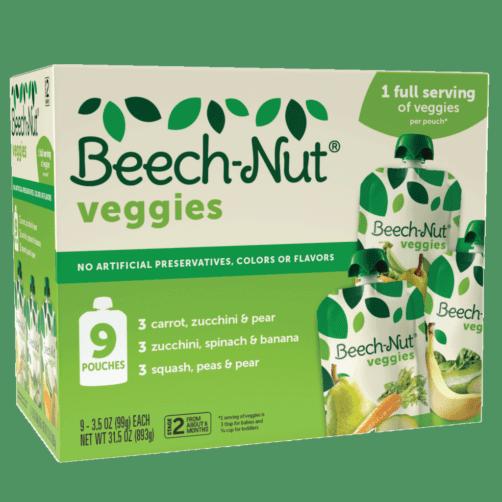
Try a variety pack to see which flavor baby likes best!
Our baby food pouches are a delicious way to squeeze more fruits and veggies into your little one’s day. This Stage 2 puree is ideal for your baby 6 months and up.
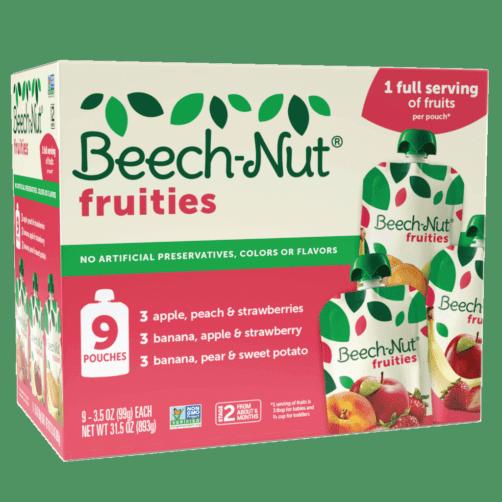



Nursing may be “natural” but that doesn’t mean it comes naturally. Here are four steps that can set you up for success, should you choose to breastfeed.
Get an early start. If you can, try to breastfeed within an hour of delivery when your baby is most alert. This will also help your newborn adjust to the outside world and bond with you right away.
2
Learn how to latch. A proper latch helps prevent sore nipples for you and ensures enough milk for your baby. If you’re unsure what this looks like, don’t hesitate to ask a nurse, pediatrician, or lactation consultant.
3
Nurse frequently. Your newborn will help your body establish a robust milk supply through frequent nursing. Every two hours or each time they cry, put them on your breast to suck.
4
Ask for help. Most hospitals have lactation consultants on staff. In addition to helping you get a proper latch, they can guide you in experimenting with different positions.

83 % of newborns start out breastfeeding.


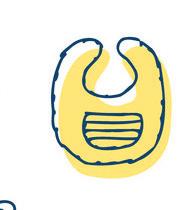
Given the dizzying variety of infant formulas on the market, you may be wondering how to choose one for your baby. The Food and Drug Administration regulates formulas to ensure that they’re safe and contain the most essential nutrients, so you can rest assured that all commercial formulas will meet your baby's basic nutritional needs. Ask your pediatrician if they recommend a formula with DHA, prebiotics, or other nutrients. If there’s a family history of allergies, you believe your baby is lactose intolerant, or you have other health concerns, your pediatrician can steer you toward the formula best suited for your child’s needs.

Look for these signs from your newborn:
• Turns their head to the side with their mouth open.
• Licks their lips.
• Sucks on their hands or anything within reach like your arm or shirt.
• Nuzzles against your chest.
• Fusses or cries.

• Appears content.
• Discontinues sucking.
• Turns away from the breast or bottle.
• Falls asleep.
It’s one of the most common questions among new breastfeeding parents: Is my baby getting enough breast milk? The good news is that most people who nurse do produce enough milk; it’s estimated that only 5% to 15% of all breastfeeding parents truly have low milk supply. Your baby’s diaper output is a reliable indicator that they’re getting enough milk. Most breastfed infants wet six to ten—and soil at least three—diapers a day in the first month.
Whether you’re using formula or expressed breast milk, here are some pointers for bottle-feeding.
FEED ON DEMAND.
As a general guide, your newborn will probably take between two and four ounces per feeding during their first few weeks (during the first few days, they may take less than an ounce), and will probably be hungry every two to four hours.
GET IN POSITION.
Cradle your baby in a semi-upright position and support their head. To prevent them from swallowing air as they suck, tilt the bottle so the formula or breast milk fills the neck of the bottle and covers the nipple.
BURP YOUR BABY
Bottle-fed infants are more like to swallow air during feedings. To prevent a tummy full of air, try burping them after every two or three ounces. If your baby doesn’t burp after a couple of minutes of trying, resume feeding.
EXPERIMENT WITH BOTTLES AND NIPPLES. They vary in material, shape, and other features, and you won’t know what your baby likes until they try it, so choose a few to test out.
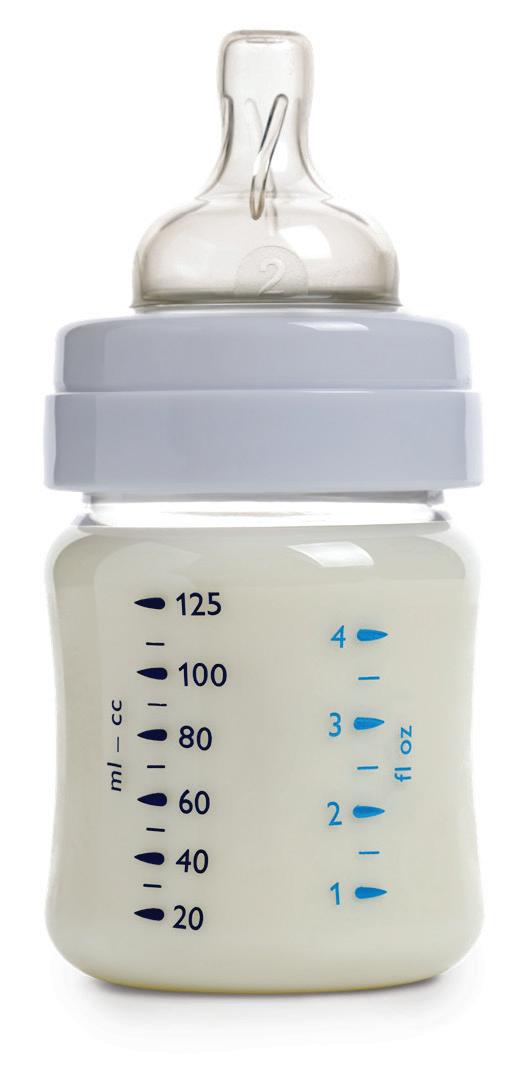
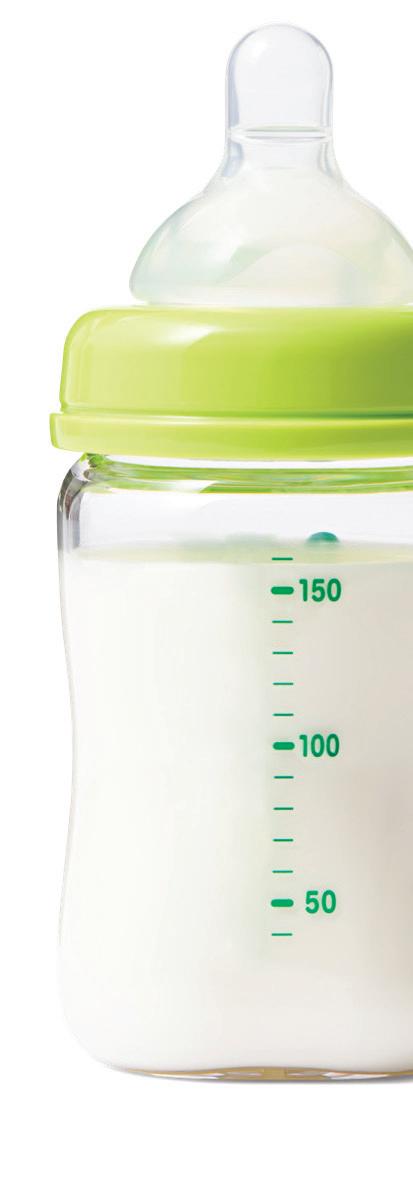


Is it time for your baby to eat (or slurp or dribble) solid foods? The American Academy of Pediatrics says they can start between 4 and 6 months, but the timing really depends on your child. Look for these signs of readiness:
• They can sit upright and hold up their head.
• They are curious about everything, especially about what you’re eating.
• They follow your fork with their heads and may open their mouths to try to take a bite.
• They lost the tongue thrust reflex that automatically pushes food out of their mouth.
• They still seem hungry after getting a full day’s portion of milk or formula (8 to 10 breastfeedings or about 32 ounces of formula).

Experts used to recommend delaying the introduction of common allergens like peanuts for fear of allergic reaction. However, new research has shown there’s no need to do so. Babies can have nearly all safe foods that would be typically introduced during the first year as early as 6 months without issue. Instead of whole peanuts or a spoonful of peanut butter, which are choking hazards, spread a little PB on toast sticks or stir a bit into puree. If you have a family history of food allergies or severe eczema, talk to your pediatrician about the best ways to introduce common allergens.
How Do I…



Until your baby turns 1, the bulk of their calories and nutrition will still come from breast milk or formula. Introducing solids is more about getting used to chewing and swallowing, so think of them as a “bonus” food.
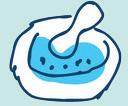
Start slow. You may want to begin with a tablespoon or two of puree or infant cereal. The first exposures are about touching and smelling the food—and maybe getting some into their mouth.

Follow baby’s lead. There’s not really clear guidance on the exact amount babies should eat; it all depends on their hunger cues and appetite.
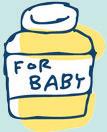
Offer variety. There are also no hard and fast rules for a baby’s first foods. (Gone are the days when bland rice cereal was the norm.) It’s more important to introduce different pureed fruits, veggies, and meats in any order to familiarize your baby with different tastes.




BEST FIRST FOOD: Beech-Nut Oatmeal Baby Cereal
As your baby progresses from purees to mashed or strained foods and finger foods, be sure to offer a variety of flavors and nutrients.
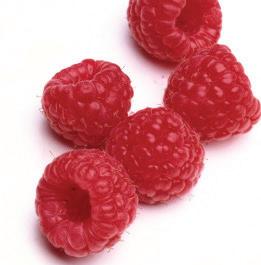
FOR FRUITS AND VEGGIES, a good guide is to “eat the rainbow.” Serve up colors from red (raspberries) to purple (eggplant) and everything in between. Cut into small pieces.
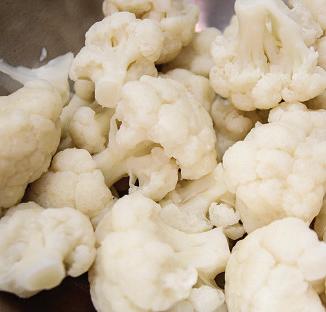
ONCE YOUR BABY CAN GRASP OBJECTS between their thumb and forefinger, try finger foods like chopped well-steamed cauliflower or slices of wellcooked egg omelet.
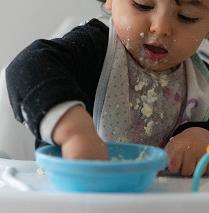
YOUR BABY MAY MASH OR SMEAR THEIR FOOD to learn more about it. Embrace the mess! Eventually they’ll lick their fingers and realize it tastes yummy too.

BABIES THIS AGE EAT WHEN THEY’RE HUNGRY. Feed your baby more if they want to, but don’t force them if they push food away.
In addition to avoiding choking hazards like grapes, hot dogs, and popcorn, you’ll want to stay away from honey. It can cause botulism in babies under 1. Also hold off on introducing cow’s milk (as a drink) until your child turns 1 because young babies can’t digest it well. It’s fine to use cow’s milk in cooking or baking, though. Cheese and yogurt are also OK.
This creamy, easy-todigest oatmeal has 60 percent of the daily value for iron, plus zinc and vitamin D, with no GMOs, sweeteners, or salt.
BEST FOR VARIETY: Beech-Nut Naturals Baby Food
You can feel reassured knowing your baby is enjoying simple, non-GMO ingredients with no added sweeteners or artificial preservatives, colors, or flavors.







These delicious yogurt bites contain probiotics and are an ideal first snack that melts in your baby’s mouth.
BEST FINGER FOOD: Beech-Nut Melties

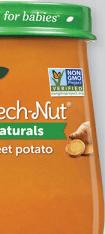

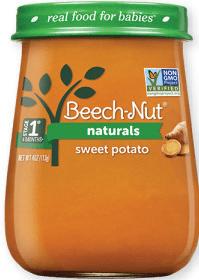







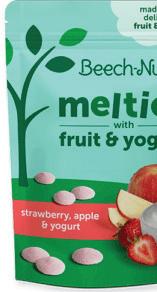


Fun, healthy meal ideas that offer different tastes and textures for your older baby (9- to 12-months old):
• OATMEAL Make unsweetened oatmeal with breast milk or formula. Stir in mashed bananas or steamed pears.
• EGGS Add a dollop of low-sodium cottage cheese to scrambled eggs. You can also mix in mashed tofu or softened veggies.
• YOGURT Add jarred or steamed fresh fruit or veggies to unsweetened full-fat yogurt.


• MAC & CHEESE Toss whole-wheat pasta with butter and shredded cheese. Stir in pureed green veggies, mashed beans, or shredded meat.
• BAKED POTATO Mash a baked sweet or white potato (skin removed) with butter, cheese, and soft veggies.
• FAMILY DINNER Your own meal is fair game if there aren’t any choking hazards. Simply run your baby’s portion through a food processor to make baby-safe bites.



What can you expect as your child turns 1? Here, some feeding challenges—and solutions—you might encounter as your child grows.
Your previously adventurous eater may turn finicky as they enter toddlerhood. This is normal—most kids go through phases of pickiness as they assert their independence. In the meantime:
•Be patient and persistent. It can take 10 to 15 tries before a child eats a new food.
•Give them foods they like for meals along with small portions of unfamiliar foods.
•Take advantage of snack time to diversify their diet with fruits, veggies, and proteins. If you're looking for on-the-go packaged options, aim for those that contain healthier ingredients like whole grains, fruits, and vegetables, and no artificial colors or flavors.
The Dietary Guidelines for Americans recommends toddlers ages 1 to 3 years consume 700 mg of calcium per day (the equivalent of 2 to 3 cups of milk a day), but it doesn’t all have to come from milk. Dairy foods like yogurt and cheese or toddler nutrition drinks containing calcium are also kid-friendly options.
Occasional treats are okay, but you’ll want to avoid using them as a reward for finishing a meal. This places sweets on a pedestal, making cues other than hunger more important. If your child won’t finish a meal without a promised dessert, don’t make it a big deal. Your job is to offer a variety of healthy foods. Your child can decide how much they’re going to eat. Eventually, hunger—rather than the promise of dessert—should be enough motivation to eat meals.























Give them the nutrition they need, wherever you are.
Beech-Nut Baby and Toddler Food Pouches are made with real ingredients and packed in convenient pouches for on-the-go feeding.

Try a variety pack to see which flavor baby likes best!
Our baby food pouches are a delicious way to squeeze more fruits and veggies into your little one’s day. This Stage 2 puree is ideal for your baby 6 months and up.

